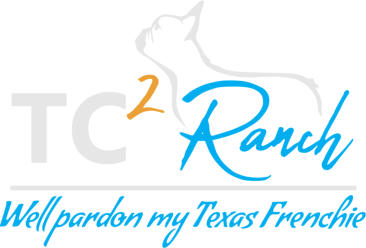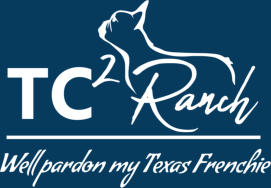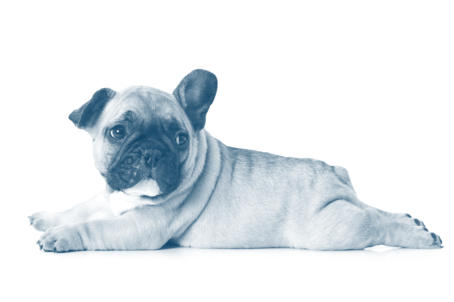903-714-1076
TC 2 Ranch | 903-714-1076
All Rights Reserved - Designed by Beaon Grafix, Inc.
903-714-1076
mrs.cnghm2@yahoo.com
Puppy Care
Prepare your home!
Once you receive your new puppy, it’s time to prepare your home for the new addition. You will need some supplies, and
while you may not want to purchase every item on this list initially, it is a good idea to have some of the basics ready
when your Frenchie arrives. Consider the weather in your area. If it’s cold and your dog shivers, consider getting a dog
sweater or jacket.
Gates
You may want to limit your puppy to certain rooms or keep your Frenchie from going up or down stairs. Baby gates work
well, but a small puppy can scoot underneath them. A better choice is a gate made especially for dogs, and there are
many styles from which to choose. These gates can be free-standing, screwed into the wall, or pressure mounted, which
means that the tension from a spring holds the gate in place. Make sure that the bars on the gate are close enough
together that the puppy cannot get their head stuck. A young pup who likes to chew, a wooden gate may not be the best
choice.
Bed
Dog beds come in a wide variety of styles, from thin pads to orthopedic foam to soft, loosely padded pillows. Of course,
your frenchie’s favorite place to sleep will be based on how it suits their idea of comfort. Frenchies are known for
destroying their bed. We think it has something to do with comfort??? They are lap dogs; therefore thin pillows or; flat
center beds are their preference. When you do zero in on the right kind of bed, be sure that it is large enough to let your
puppy stretch out and relax. It should also be washable or have a removable washable cover. If your Frenchie likes to
chew and rip things up, wait until he/she outgrows this phase before you buy a expensive bed. Frenchies sleep fine on a
nice cozy blanket!
Harness
We recommend investing in a harness. Collars sometimes a strain on their neck. A harness will support their chest and
neck. The safest basic harness for everyday wear is “thin” made of nylon, fabric, or leather and fastened with a buckle or
a quick-release fastener.
Check the harness’s fit frequently, especially while your Frenchie is growing, and readjust or replace it when it no longer
fits. You should be able to insert two fingers between the harness and your Frenchies neck. Tighter than that is too tight
for comfort and safety, and a harness that hangs looser than that can get caught on things and trap or strangle your
Frenchie. Harnesses, like the Puppia Soft Dog Harness (one of our favorite), are a popular alternative to the traditional
collar; they solve the problem of a collar chocking your Frenchie's neck. If you like harnesses for everyday or occasional
use, retailers carry many fashionable choices in a variety of comfortable styles.
Crate
Many Frenchie owners bark at the idea of a crate, but from the Frenchies point of view, the confined space is like a cozy
den. Puppies like to have a place where they can curl up in security, privacy and call their "own". Crates come in a few
basic types, including wood, wire, and plastic. Wood enclosures are expensive, heavy, and can be difficult to clean. Wire
crates are easy to clean and provide good ventilation for your Frenchie. How big should your frenchie crate be? A crate
must be big enough so that your puppy can easily stand up in it and turn around. For puppies we recommend, invest in a
crate divider to make the enclosure smaller; this will help when you begin the housetraining process. If the crate is too
large, your pup may claim one section as their sleeping area and use the excess space as their potty area. You want this
first crate to be big enough to be a bedroom, not a master suite with private bathroom. As for potty training, we
recommend after feed take your frenchie outside to a designated area (20 minutes) after eating for potty. This process
may take up to 30 minutes of waiting patiently. Once your Frenchie have potty successfully, praise and reward with a
treat! This process may take a few weeks, however well worth the effort! We began potty training at 4-6 weeks. With your
consistent effort, your puppy training will be a success!
Identification
When you take your Frenchie to the vet for their immunization follow-up, your vet may offer microchip and/or dog's tags.
When attached to your Frenchie’s harness, this item can help identify your Frenchie; if he ever becomes lost. To the
average person on the street, however, this number alone means nothing. A better way to provide your dog with
identification is to microchip. Personalized tags are extremely inexpensive and easy to find. Include your Frenchie’s name,
your address, and your phone number (including area code). And don’t forget to attach the tag to your frenchie's harness.
The most permanent form of identification is a microchip. If your Frenchie is ever stolen, a tag will do little to bring your
frenchie back to you. Microchipping is a much more permanent and effective choice. A canine microchip, which is
approximately the size of a grain of rice, can be inserted under your Frenchie's skin (typically between his shoulder
blades) with a needle during a routine veterinary visit with absolutely no anesthesia. Your Frenchie's unique number is
then registered with the appropriate company. If your pup becomes lost or stolen, a veterinarian or animal shelter worker
can scan the chip to confirm his identity.
Toys
Frenchies have strong grips. We do not recommend plastic, thin chewable toys. When selecting a toy for your frenchie, try
to think like he does. Ribbons, bells, plastic eyes, noses, and whatever other doodads are attached to that cute little toy
are something to be ripped off, chewed up, and sometimes swallowed. The innards (stuffing) can be ripped out and
sometimes eaten as well. We offer our Frenchies only; deer antlers (great for teething), tied ropes and dog tennis balls.
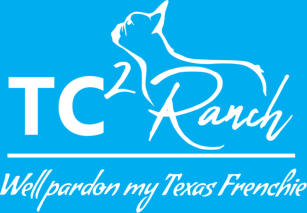
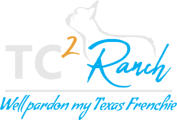
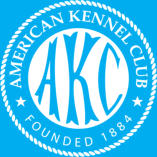


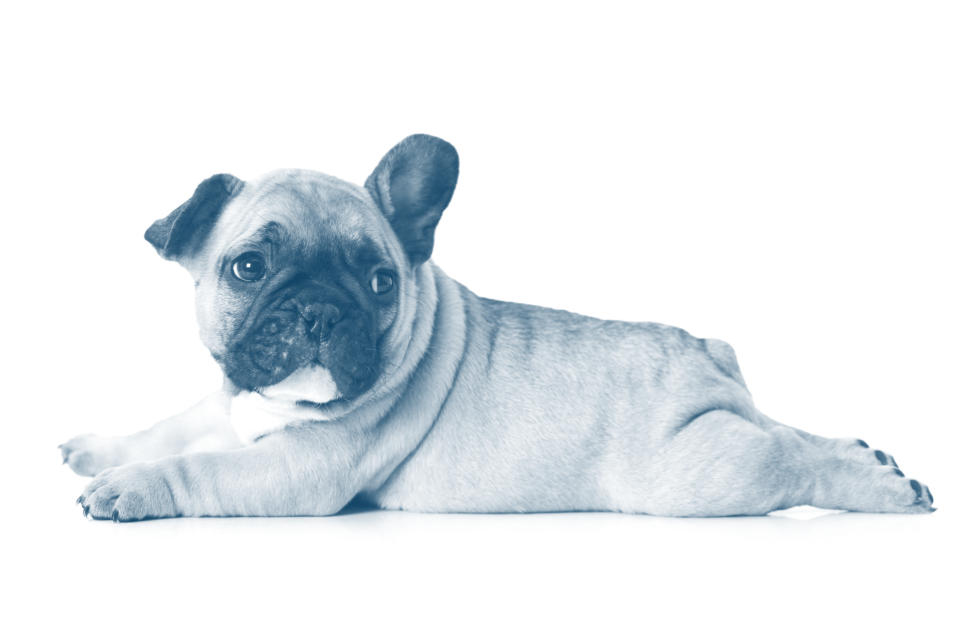




903-714-1076
Puppy Care
Prepare your home!
Once you receive your new puppy, it’s time to prepare
your home for the new addition. You will need some
supplies, and while you may not want to purchase every
item on this list initially, it is a good idea to have some of
the basics ready when your Frenchie arrives. Consider
the weather in your area. If it’s cold and your dog
shivers, consider getting a dog sweater or jacket.
Gates
You may want to limit your puppy to certain rooms or
keep your Frenchie from going up or down stairs. Baby
gates work well, but a small puppy can scoot
underneath them. A better choice is a gate made
especially for dogs, and there are many styles from
which to choose. These gates can be free-standing,
screwed into the wall, or pressure mounted, which
means that the tension from a spring holds the gate in
place. Make sure that the bars on the gate are close
enough together that the puppy cannot get their head
stuck. A young pup who likes to chew, a wooden gate
may not be the best choice.
Bed
Dog beds come in a wide variety of styles, from thin
pads to orthopedic foam to soft, loosely padded pillows.
Of course, your frenchie’s favorite place to sleep will be
based on how it suits their idea of comfort. Frenchies
are known for destroying their bed. We think it has
something to do with comfort??? They are lap dogs;
therefore thin pillows or; flat center beds are their
preference. When you do zero in on the right kind of
bed, be sure that it is large enough to let your puppy
stretch out and relax. It should also be washable or
have a removable washable cover. If your Frenchie
likes to chew and rip things up, wait until he/she
outgrows this phase before you buy a expensive bed.
Frenchies sleep fine on a nice cozy blanket!
Harness
We recommend investing in a harness. Collars
sometimes a strain on their neck. A harness will support
their chest and neck. The safest basic harness for
everyday wear is “thin” made of nylon, fabric, or leather
and fastened with a buckle or a quick-release fastener.
Check the harness’s fit frequently, especially while your
Frenchie is growing, and readjust or replace it when it
no longer fits. You should be able to insert two fingers
between the harness and your Frenchies neck. Tighter
than that is too tight for comfort and safety, and a
harness that hangs looser than that can get caught on
things and trap or strangle your Frenchie. Harnesses,
like the Puppia Soft Dog Harness (one of our favorite),
are a popular alternative to the traditional collar; they
solve the problem of a collar chocking your Frenchie's
neck. If you like harnesses for everyday or occasional
use, retailers carry many fashionable choices in a
variety of comfortable styles.
Crate
Many Frenchie owners bark at the idea of a crate, but
from the Frenchies point of view, the confined space is
like a cozy den. Puppies like to have a place where they
can curl up in security, privacy and call their "own".
Crates come in a few basic types, including wood, wire,
and plastic. Wood enclosures are expensive, heavy,
and can be difficult to clean. Wire crates are easy to
clean and provide good ventilation for your Frenchie.
How big should your frenchie crate be? A crate must be
big enough so that your puppy can easily stand up in it
and turn around. For puppies we recommend, invest in
a crate divider to make the enclosure smaller; this will
help when you begin the housetraining process. If the
crate is too large, your pup may claim one section as
their sleeping area and use the excess space as their
potty area. You want this first crate to be big enough to
be a bedroom, not a master suite with private bathroom.
As for potty training, we recommend after feed take
your frenchie outside to a designated area (20 minutes)
after eating for potty. This process may take up to 30
minutes of waiting patiently. Once your Frenchie have
potty successfully, praise and reward with a treat! This
process may take a few weeks, however well worth the
effort! We began potty training at 4-6 weeks. With your
consistent effort, your puppy training will be a success!
Identification
When you take your Frenchie to the vet for their
immunization follow-up, your vet may offer microchip
and/or dog's tags. When attached to your Frenchie’s
harness, this item can help identify your Frenchie; if he
ever becomes lost. To the average person on the street,
however, this number alone means nothing. A better
way to provide your dog with identification is to
microchip. Personalized tags are extremely inexpensive
and easy to find. Include your Frenchie’s name, your
address, and your phone number (including area code).
And don’t forget to attach the tag to your frenchie's
harness. The most permanent form of identification is a
microchip. If your Frenchie is ever stolen, a tag will do
little to bring your frenchie back to you. Microchipping is
a much more permanent and effective choice. A canine
microchip, which is approximately the size of a grain of
rice, can be inserted under your Frenchie's skin
(typically between his shoulder blades) with a needle
during a routine veterinary visit with absolutely no
anesthesia. Your Frenchie's unique number is then
registered with the appropriate company. If your pup
becomes lost or stolen, a veterinarian or animal shelter
worker can scan the chip to confirm his identity.
Toys
Frenchies have strong grips. We do not recommend
plastic, thin chewable toys. When selecting a toy for
your frenchie, try to think like he does. Ribbons, bells,
plastic eyes, noses, and whatever other doodads are
attached to that cute little toy are something to be
ripped off, chewed up, and sometimes swallowed. The
innards (stuffing) can be ripped out and sometimes
eaten as well. We offer our Frenchies only; deer antlers
(great for teething), tied ropes and dog tennis balls.
